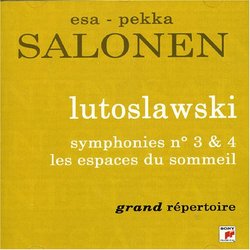Two masterpieces and a solid late work
Christopher Culver | 06/19/2006
(5 out of 5 stars)
"This Sony disc containing three works by Witold Lutoslawski is already something of a legend. It contains three world premiere recordings of some of his grandest pieces, interpreted by the L.A. Philharmonic and its acclaimed conductor Esa-Pekka Salonen, with John Shirley-Quirk as baritone solo in the middle work. It should be mentioned that this version is what appears to be a European reissue, and is import-priced. The original recording is available domestically in the US and is a more economic purchase.
"Symphony No. 3" (1983) was commissioned in the early 1970s by the Chicago Symphony Orchestra, but appeared only a decade later after several false starts. It lies in between two clearly defined eras of the composer's work, containing both the aleatorism of the 1960s and 1970s and hints of the return to accessibility of his late neoclassical phase. Nonetheless, each of these two tendencies is blunted so that they exist in great harmony, forming a piece that is quite different from his other works though unmistakably Lutoslawski. The score is precisely notated--there are no "wavy lines" here, but the element of chance is provided by a large series of "ad libitum" sections which are unconducted. I've always had a hard time hearing an overall form for this piece, which starts from a series of hammering E notes and then wanders off. The composer claims that it's got four sections, but I have a hard time hearing it. However, that does not mean that the Third is boring. The frustration of not being able to speak of the structure of the symphony makes it harder for me to communicate to readers here just how great it is. It might be a somewhat formless blog, but it is beautiful, and in the end when this formlessness suddenly takes on a very directed form towards a quasi-romantic finale and ends on the same hammering E's., it's stunning.
"Les Espaces du Sommeil" for baritone and orchestra (1975) is a magisterial setting of Robert Desnos' poem about how in sleep we enter an irrational world of rich possibilities. While initially drifting, uncertain, lost, the music comes to a crashing climax. This is less immediately accesible than either of the other two pieces here, but slowly reveals its charms, and now I think it is my favourite piece for baritone out of all such compositions in the 20th century.
"Symphony No. 4" (1992) was written towards the end of Lutoslawski's career, some time after he had exchanged the rich avant-gardism of his middle period for a much more restrained style. Aleatorism still plays a role (but quite diminished), but the harmonies are more conventional and there is a more lyrical touch. I'm not too happy with this symphony, it certainly pales next to the Second and Third, but the brighter side of things is that it's not as dull as most of Lutoslawski's late work.
The major competition is from Naxos, which has the Polish Radio Symphony Orchestra conducted by Antoni Wit. Both Salonen and Wit do equally well, and there's little to complain about in terms of performance. What this Sony disc has going for it are are excellent liner notes, containing not only the usual description of the works and the sung text, but also Salonen's personal reminiscing of what Lutoslawski's music means to him. Since the Third is often seen as Lutoslawski's masterpiece, this disc would make a great introduction to his art, and its an economical purchase. I should mention, though, that if you like the Third, the very next disc you should buy is the Naxos release with his "Chain 3", very similar in sound."


 Track Listings (3) - Disc #1
Track Listings (3) - Disc #1